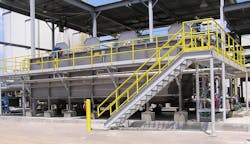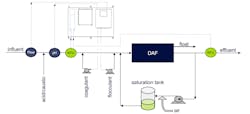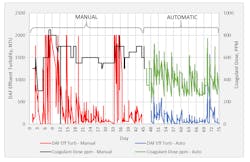Many food manufacturing plants have wastewater containing fats, oil and grease (FOG). Removing FOG prior to discharging to either a publicly owned treatment works (POTW) or secondary treatment system on-site often requires pretreatment by dissolved air flotation (DAF). DAF units come in various types, but one element that is common to all is the use of coagulants and/or flocculants to maximize FOG and solids removal.
The DAF process is similar to gravity clarification in reverse. Wastewater is dosed with treatment chemicals upstream of the DAF inlet. A portion of the DAF effluent is recycled to a pressurization vessel or specialized pump to saturate the stream with air. Air saturated recycle is then introduced to the DAF flotation section. As the pressurized recycle is exposed to atmospheric conditions, microbubbles are released and attach to the suspended solids, floating them to the top. Proper coagulant and flocculant dosing maximizes particle capture and ensures solids particles are large and stable enough to be successfully floated to the surface. DAF solids are harvested by top scrapers, operating either continuously or intermittently. Depending on the application, DAF effluent turbidity can be below 10 NTU. DAF float solids can reach up to 5% and are typically either disposed off-site or collected by a third party for introduction to animal feed.
Flow-based chemical dosing control can be adequate for sites with fairly consistent DAF influent water quality to meet performance requirements. Sites that have highly variable DAF influent quality, however, often struggle with chemical feed optimization. Three basic chemical dosing strategies are typically employed for variable influent quality: dosing to average conditions, worst-case conditions, and manual adjustment. Each method has disadvantages, as summarized in Table 1.
For a North American manufacturer of oily food products, chemical feed automation based on DAF influent parameters (e.g., turbidity, flow), coupled with online monitoring data visibility, was demonstrated to improve DAF performance, optimize chemical usage and ease troubleshooting.
DAF chemical feed manually adjusted
A food manufacturing plant in the U.S. pretreats its wastewater by DAF prior to discharge to a POTW. Use charges from the POTW are based on five-day biochemical oxygen demand (BOD5), total suspended solids (TSS) and flow. Oil is on the ingredient list for several products, and therefore emulsions in the wastewater are common. Because the site produces a range of different products, DAF influent wastewater parameters are highly variable. Equalization dampens out some of the load variations, but their tank capacity is limited, as in many sites.
Coagulant and flocculant dosing were historically adjusted manually based on operator experience with each wastewater process and visual inspection of the DAF effluent quality. The wastewater treatment unit is in a separate building from the production units, and monitoring/control instrumentation is local only. This physical distance, coupled with the lack of an assigned full-time operator, meant DAF effluent quality could deteriorate, leading to higher charges from the POTW. To combat higher charges, operators would often overfeed chemicals to preemptively catch any changes in the DAF influent wastewater.
Automated chemical feed solution
The chemical supplier and site engineering personnel decided to trial the TrueSense* DAF Chemical Feed Automation Panel to monitor the online turbidity of DAF influent and effluent and use the information to adjust coagulant and flocculant dosing. As with any chemical program, initial dosing curve algorithms were developed by on-site jar testing. Samples were collected several times over a period of days to catch as many process operating conditions as possible.
Jar testing included chemical oxygen demand (COD) analysis to develop a correlation between COD and effluent turbidity that could be used to estimate BOD5 (historical data indicated a >0.9 BOD to COD ratio). Analysis indicated that by controlling DAF effluent turbidity to <150 NTU, COD could be reduced by up to 45%. The remaining COD in the effluent was found to be soluble and, therefore, not treatable by flotation.
Dosing curve algorithms were programmed into the Panel controller. Signals (4-20 mA) for pH and flow from the site’s system were also connected to the Panel. To address concerns of fouling, self-cleaning turbidity sensors were used to minimize operator maintenance requirements and ensure accurate readings.
Based on the configuration of the DAF and its piping, the decision was made to use tank immersion-type turbidity sensors. Inline insertion-type sensors were also considered; however, the immersion sensors were easier to install because they involved no line cutting. The controller uses the influent flow and turbidity readings to calculate flow proportioned dose rates for the coagulant and flocculant feed and sends the signals to the smart pumps. If DAF effluent turbidity falls within the acceptable range set by the operator, chemicals are dosed at the prescribed rate defined by the influent dosing curves. If DAF effluent does not meet quality requirements, an additional trim dose of coagulant and flocculant is added until turbidity falls into the control range.
The Panel incorporates additional design features that improve operability, including:
- Performance data and calculated removal rates are tracked and available electronically 24/7.
- Direct inline or in-tank sensors – no side-stream sampling lines, pumps or valves to foul.
- Initial dosing algorithm based on jar test data that can be adjusted with site operating data.
- Self-cleaning turbidity sensors can alternatively be set to measure TSS.
- Pumped chemical feed rate verification available to notify of mechanical issues.
Results
Coagulant use with effluent turbidity before and after placing the Panel in automatic mode is illustrated in Figure 2. Turbidity readings are recorded every five minutes. Flocculant use varied in ratio to coagulant use and is omitted for clarity.
When coagulant feed was in manual mode, effluent turbidity showed high variability with an average of 497 NTU. The maximum turbidity meter limit of 2000 NTU was reached and sustained for over an hour on several occasions. The black line for coagulant dosage shows a delay in increase — until hours after high effluent turbidity. Once effluent turbidity falls, coagulant dosage remains at elevated levels.
After the Panel was placed in automatic mode, effluent turbidity variability was significantly reduced and averaged 158 NTU — a 68% reduction compared to manual control mode. Note how the automated coagulant dosing both precedes changes in effluent turbidity and varies more, indicating that high influent FOG was caught before it could affect effluent quality. In addition to improved DAF effluent water quality, coagulant dosage was reduced from an average of 623 ppm in manual mode, down to 435 ppm average in automatic mode, resulting in a decrease of 30%. Finally, the average turbidity removal rate increased from 55% in manual mode to 78% in automatic mode.
By implementing automated coagulant dosing adjustment, DAF users will produce a more consistent effluent — lower in FOG and COD. Operating staff resources can be realigned to focus on process areas, allowing increased attention on production. Manufacturers will also have reduced operating costs by using chemicals more efficiently and minimizing third-party processing surcharges.
In addition to these benefits, the manufacturer found that the ability to monitor DAF performance with InSight*, a cloud-based asset performance management system, to be helpful in both observing daily operations and analyzing data trends.
*Trademark of SUEZ; may be registered in one or more countries.
About the author: Laura Watson is a water/wastewater chemical products senior applications engineer with SUEZ – Water Technologies & Solutions. She specializes in primary and secondary treatment of oily wastewater in food and beverage manufacturing, refining and chemical plants. Prior to joining SUEZ, she designed and performed troubleshooting of biological treatment plants for over 20 years.
About the Author
Laura Watson
Laura Watson is a water/wastewater chemical products senior applications engineer with SUEZ – Water Technologies & Solutions. She specializes in primary and secondary treatment of oily wastewater in food and beverage manufacturing, refining and chemical plants. Prior to joining SUEZ, she designed and performed troubleshooting of biological treatment plants for over 20 years.




